Translate this page into:
Leprosy literature in India: A journey through history and contemporary insights
Corresponding author: Dr. Sunil Dogra, Department of Dermatology, Venereology and Leprology, Post Graduate Institute of Medical Education and Research, Chandigarh, India. sundogra@hotmail.com
-
Received: ,
Accepted: ,
How to cite this article: Kumar B, Mehta H, Narayan RV, Narang T, Dogra S. Leprosy literature in India: A journey through history and contemporary insights. Indian J Dermatol Venereol Leprol. doi: 10.25259/IJDVL_104_2025
Leprosy, one of the oldest recorded diseases in the history of humanity, holds a unique place, blending medical, cultural, and social narratives. In India, evidence of leprosy dates back to 2000 BCE skeletal remains, with literary references appearing in the Sushruta Samhita and Arthashastra around the 6th century BCE. Indian pioneers like Charaka and Sushruta detailed its clinical features and treatments, including chaulmoogra oil and surgical innovations like rhinoplasty, underscoring India’s significant role in the global understanding of the disease.
Despite this rich history, knowledge about leprosy remained fragmented, necessitating systematic documentation. Over the years, committed authors compiled this scattered information into comprehensive texts addressing epidemiology, clinical care, and societal challenges like stigma. These works became vital resources for healthcare professionals, improving treatment practices and public awareness.
This manuscript provides a chronological review of India’s contributions to leprosy literature, showcasing the evolution of medical understanding and the efforts to combat the stigma surrounding the disease.
Leprosy Diagnosis, Treatment, and Prevention (Ernest Muir, 1926, O M Press Cuttack)
Handbook on Leprosy in 1921 by Muir was one of the earliest comprehensive texts that offered essential knowledge on leprosy diagnosis and management [Figure 1]. It included practical advice on drug preparation, such as Hydnocarpus esters, bridging traditional remedies and modern therapies. Written for both clinicians and paramedical workers, the book served as a compass for healthcare professionals tackling the disease in the early 20th century.
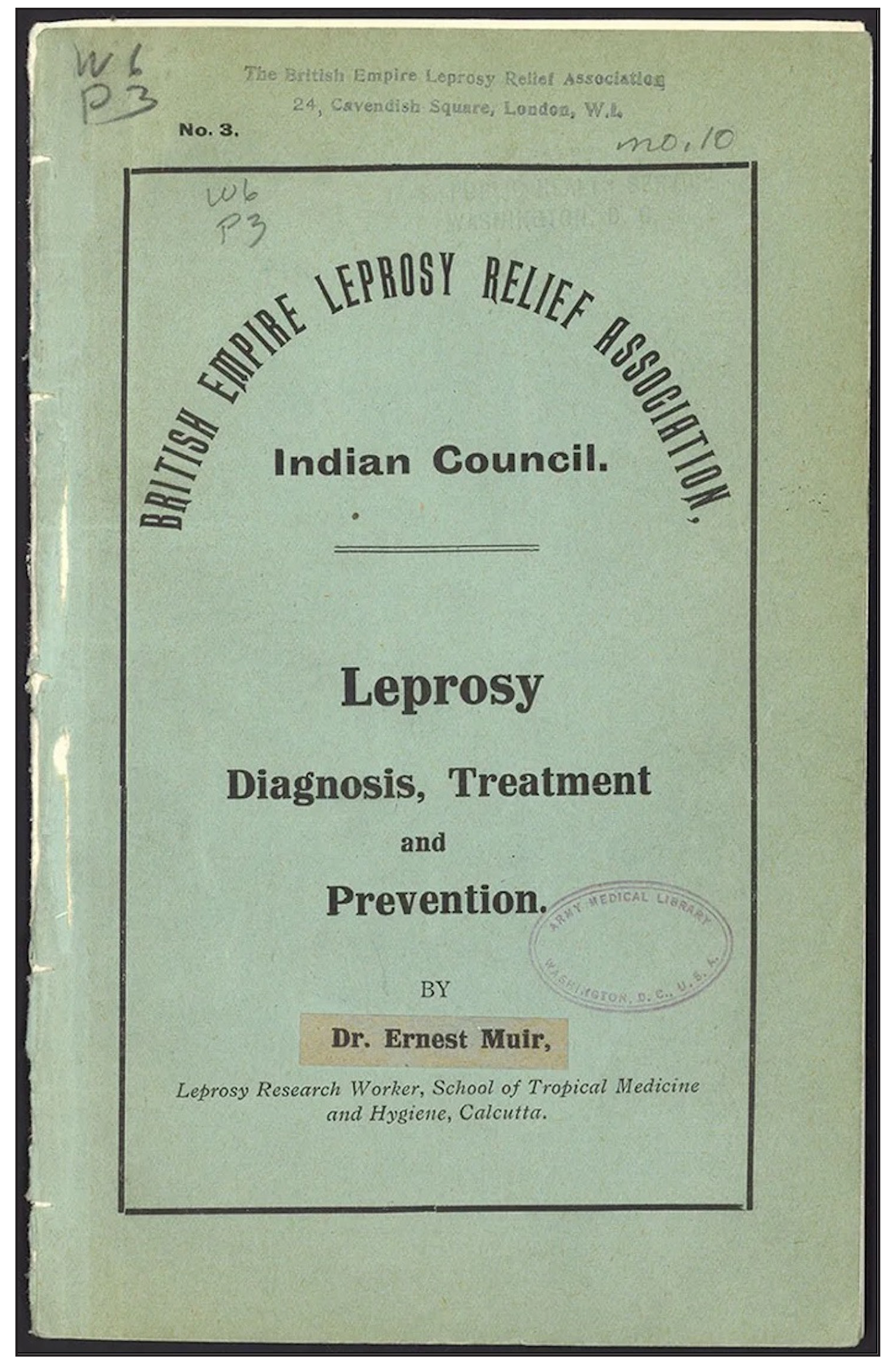
- Cover of Leprosy Diagnosis, Treatment and Prevention by Ernest Muir (1926).
Indian Journal of Leprosy (Indian Association of Leprologists, since 1929)
The Indian Journal of Leprosy (IJL) is a peer-reviewed journal dedicated to advancing leprosy research. It was launched in 1929 under the name Leprosy in India and was rebranded later in 1983. The journal features research on clinical, epidemiological, and socio-economic aspects of leprosy and contributes significantly to global understanding and policy development. Published by the Indian Association of Leprologists (IAL), IJL underscores India’s prominent role in leprosy eradication efforts.
Notes on leprosy (Dharmendra, First edition 1960, Second edition 1967, Ministry of Health, Government of India)
It was widely regarded as an authoritative resource on the clinical and practical aspects of leprosy management [Figure 2]. The book is known for its precise and methodical approach, reflecting the author’s extensive experience and deep understanding of leprosy as seen in India. With comprehensive illustrations and clear guidance on diagnosis, treatment, and control strategies, it served as a vital manual for students, general practitioners, and field workers.
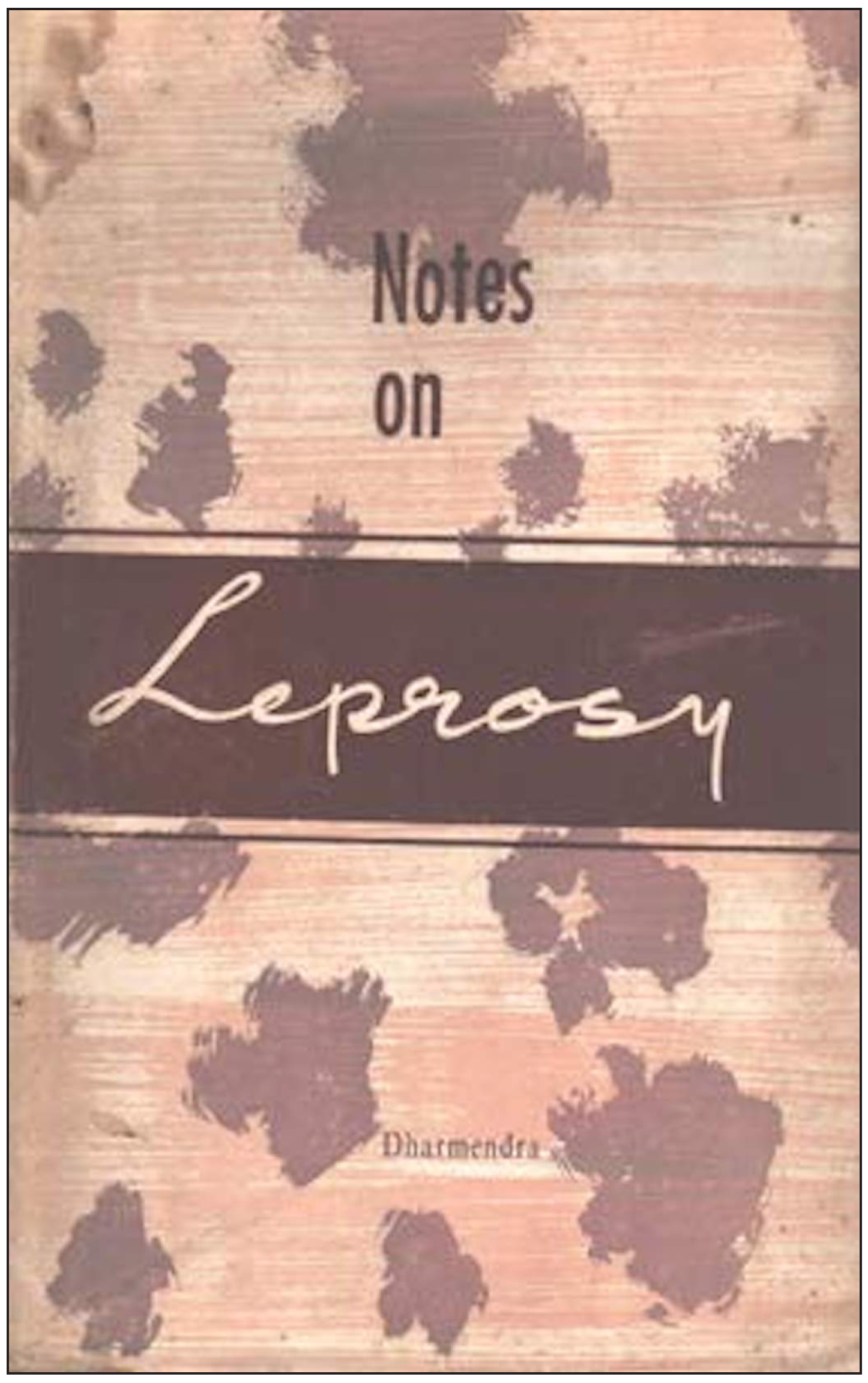
- Cover of Notes on Leprosy by Dharmendra (Second Edition, 1967).
Handbook of Leprosy (WH Jopling, First edition 1971, Seventh edition 2023, updated by Kabir Sardana and Ananta Khurana, CBS Publishers & Distributors Pvt. Ltd.)
Dr. Jopling, inspired by the dedicated efforts of paramedical workers in Africa, authored a concise handbook [Figure 3a] to educate students and general practitioners on leprosy. The book presents essential clinical concepts in a clear, accessible manner, with updates on diverse scenarios and populations, offering a comprehensive understanding of the disease.
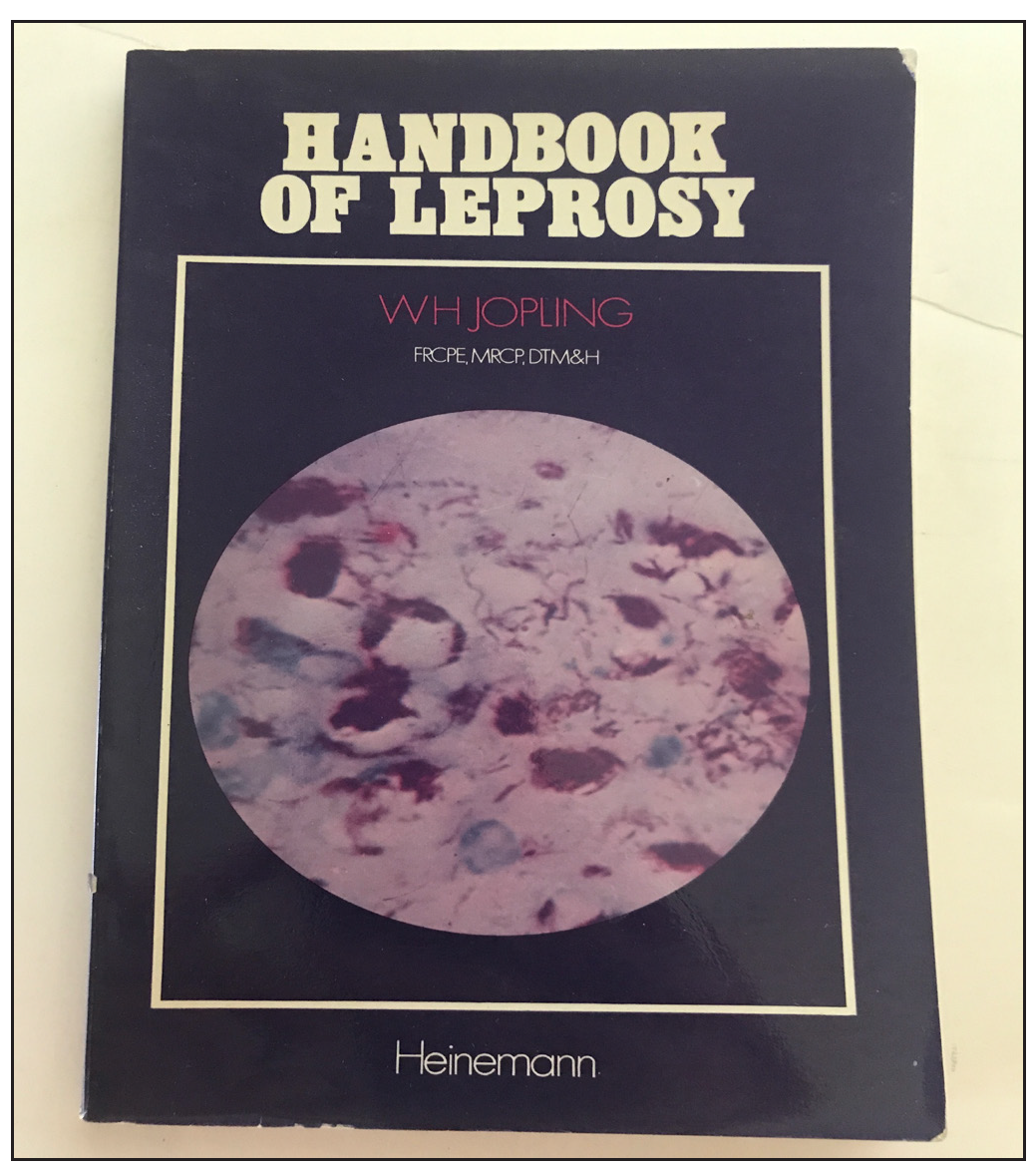
- Cover of Jopling’s Handbook of Leprosy (First Edition, 1971).
Subsequent editions expanded on this foundation, incorporating advancements in treatment, drug resistance, and prophylactic measures [Figure 3b]. The 2023 edition features an updated review of immunopathogenesis with simplified schematic diagrams, detailed diagnostic guidance, a medication formulary, and advancements in managing neural involvement and leprosy reactions. It also covers chemo- and immunoprophylaxis alongside immunotherapeutics, further solidifying its role as a key educational resource.
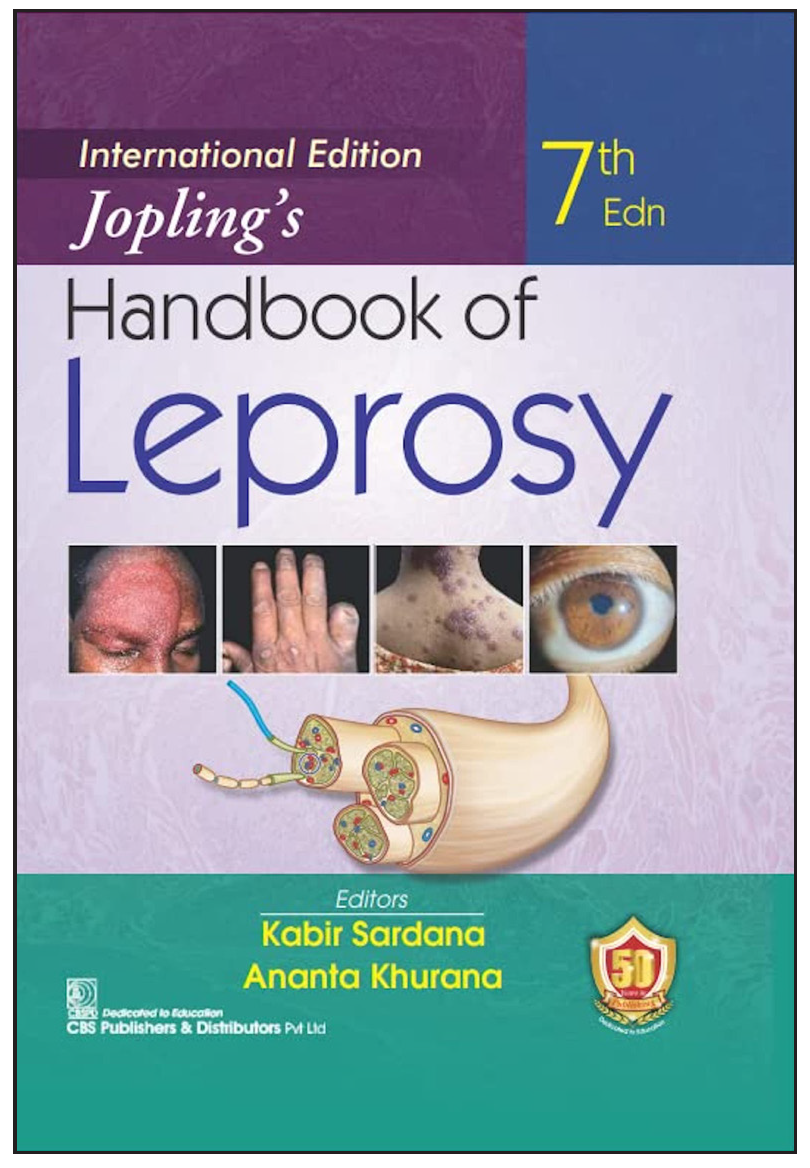
- Cover of Jopling’s Handbook of Leprosy (Seventh Edition, 2023).
Textbook of Leprosy for Students and Paramedical Workers (RH Thangaraj, 1975, The Leprosy Mission)
Thangaraj’s textbook emerged as a foundational resource during a time when leprosy was considered prevalent in tropical regions [Figure 4]. It provided clear, concise insights into clinical manifestations, diagnosis, and treatment, making it invaluable for medical students and paramedical workers. The accessible language and structured approach of the book fostered academic interest and enhanced understanding among healthcare providers.

- Cover of Textbook of Leprosy for Students and Paramedical Workers by R.H. Thangaraj (1975).
Leprosy (Dharmendra, 1978, Samant and Company)
Crafted by Dharmendra, a luminary in Indian leprology, this two-volume (1st volume was published in 1978 and 2nd in 1985) masterpiece is a landmark in leprosy literature [Figures 5a and 5b]. Structured into 13 sections with an appendix covering practical aspects like case-taking and bacteriological examination- the first volume addresses clinical aspects, while the second focuses on microbiological studies and epidemiological control. The volumes are cohesive and self-contained and catered to practitioners and researchers alike. Dharmendra also integrated socioeconomic themes like rehabilitation and education, with contributions from both national and international collaborators, solidifying the book as a cornerstone in leprosy management.
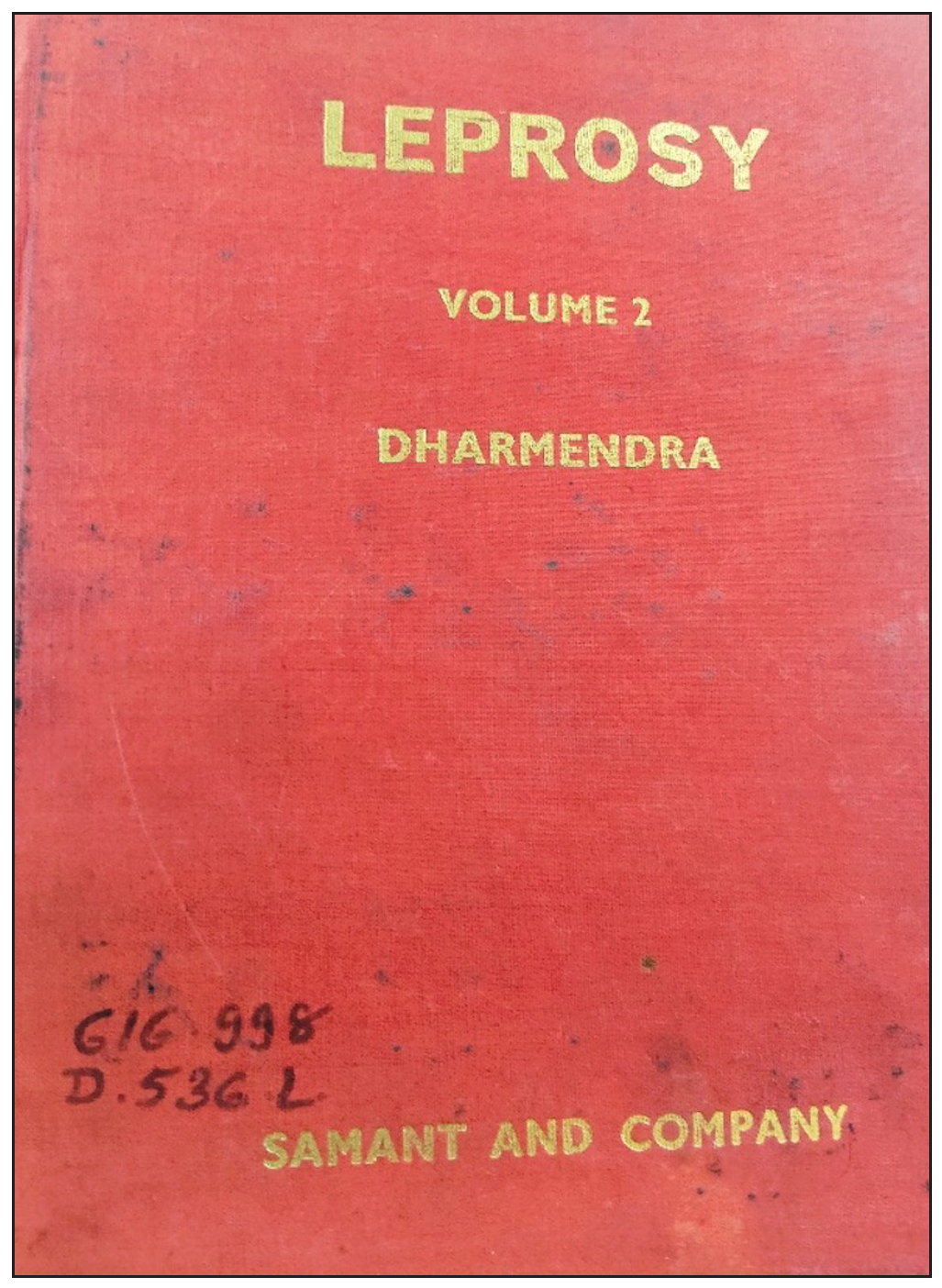
- Cover of Leprosy by Dharmendra (Second Volume, 1978).
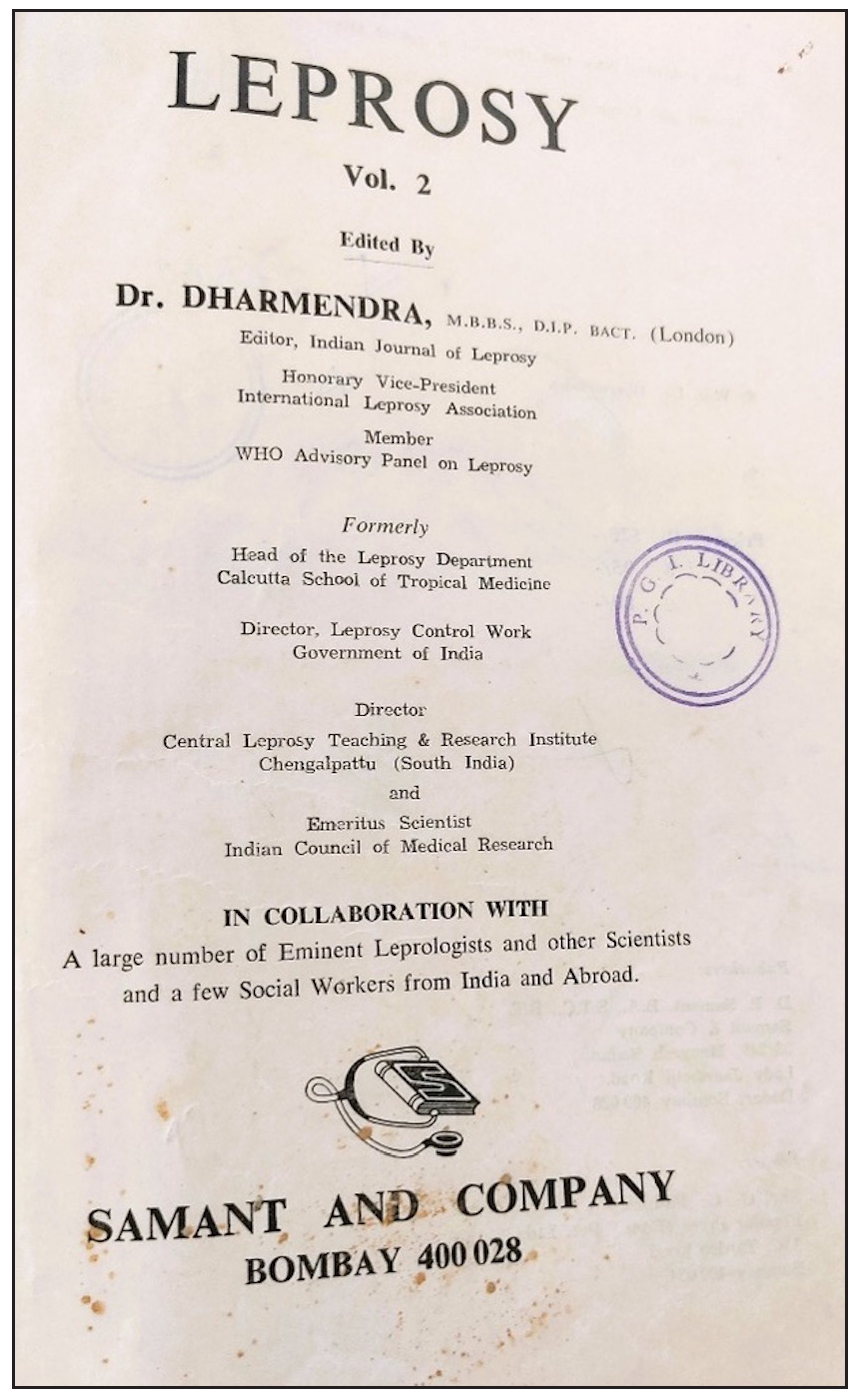
- Title page of Leprosy by Dharmendra (Second Volume, 1978).
Textbook of Clinical Leprosy (Virendra N Sehgal, First edition 1979, Fifth edition 2012, Jaypee Brothers Medical Publishers)
First published in 1979 and updated through multiple editions [Figure 6], this textbook is a foundational work in the study of leprosy. Designed for postgraduate education, the book emphasises clinical manifestations, classification, and pathogenesis. Drawing from decades of didactic lectures and clinical demonstrations, it integrates basic knowledge with the latest in treatment regimens, including the use of newer drugs.
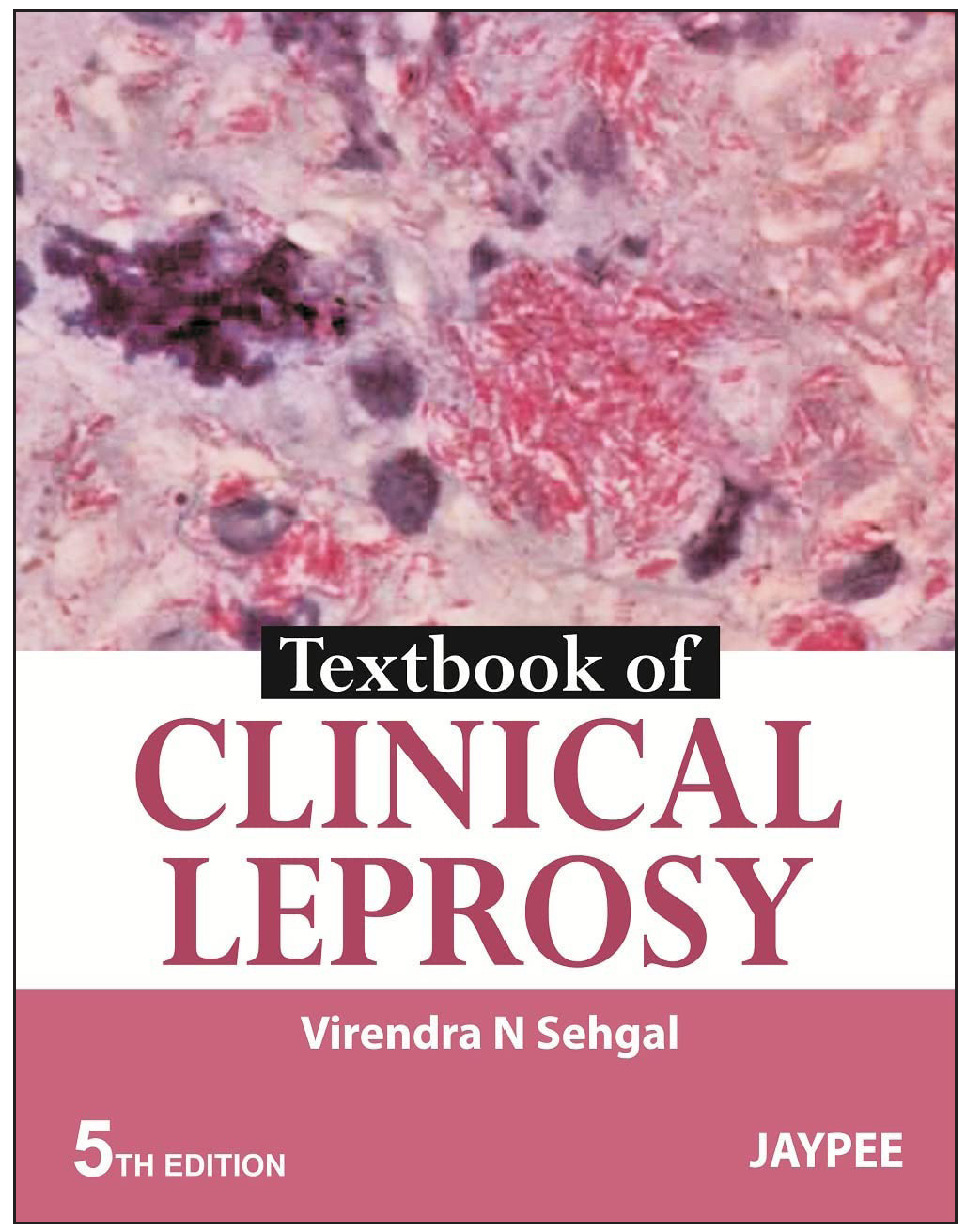
- Cover of Textbook of Clinical Leprosy by Dr. Virendra N. Sehgal (2012).
Leprosy for Medical Practitioners and Paramedical workers (R.H. Thangaraj & S.J. Yawalkar, First edition 1986, Eighth Edition 2009, S J Yawalkar, Foundation for Sustainable Development)
The book provides guidance for healthcare providers managing leprosy. It addresses the stigma and isolation historically faced by patients and stresses the transformative role of multidrug therapy in curing the disease, preventing transmission, and reducing disabilities. Designed for practitioners and paramedical workers, it focuses on early diagnosis and appropriate treatment, aiming to ensure timely care, improve outcomes, help patients lead normal lives, and break the stigma [Figure 7].
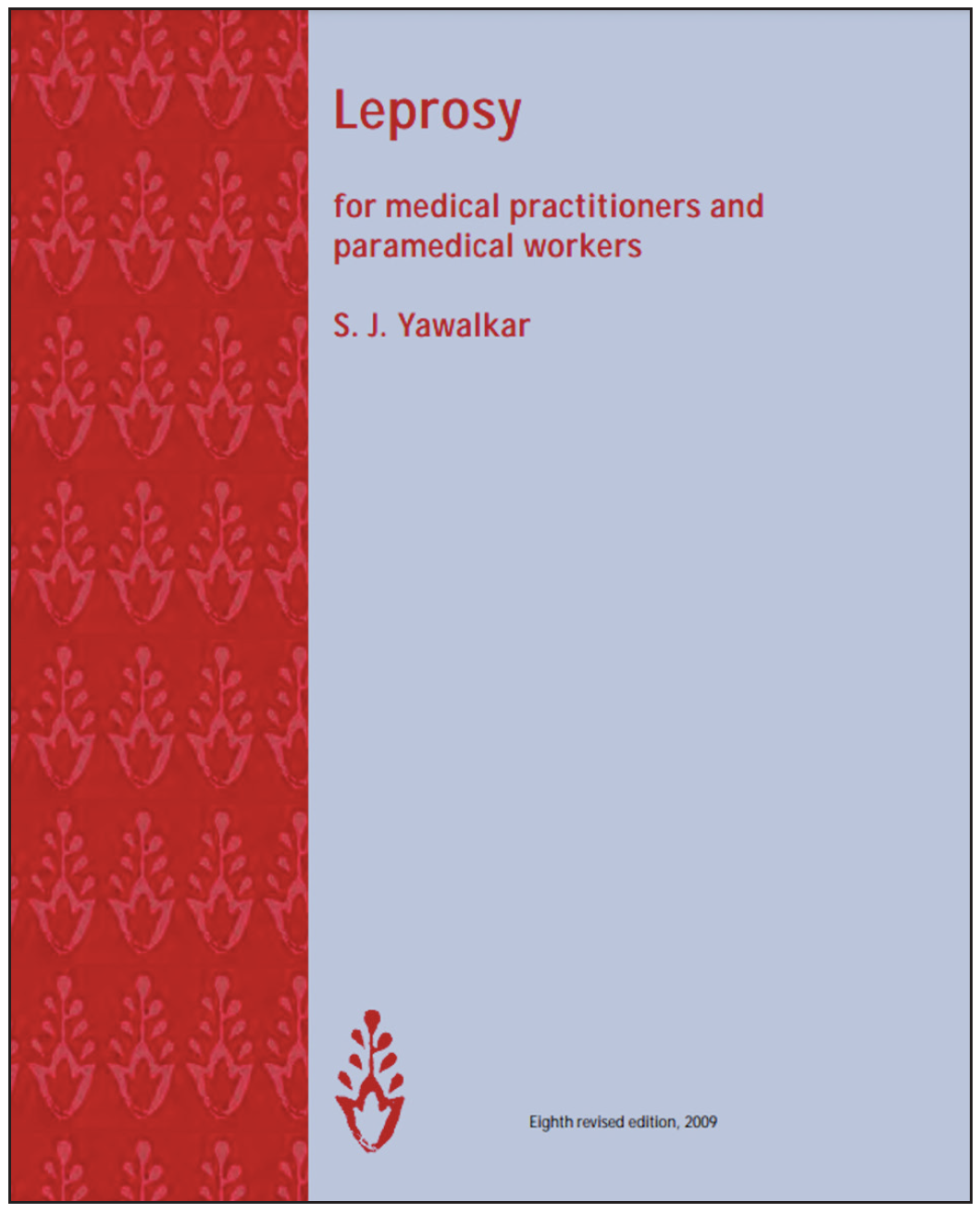
- Cover of Leprosy for Medical Practitioners and Paramedical Workers by S.J. Yawalkar (Eighth Edition, 2009).
Leprosy: A Reference Guide for Medical Practitioners Programme Managers and Leprosy Workers (R S Misra, First Edition 1993, Concept Publishing Co)
This book offers insights into the assessment of leprosy’s burden and global, regional, and endemic impact [Figure 8]. It serves as a comprehensive resource, addressing the technical challenges faced by clinicians, laboratory technicians, paramedical workers, and program managers. It also provides a detailed view of the ground realities in different regions, fostering collaboration toward a shared goal of combating leprosy effectively.
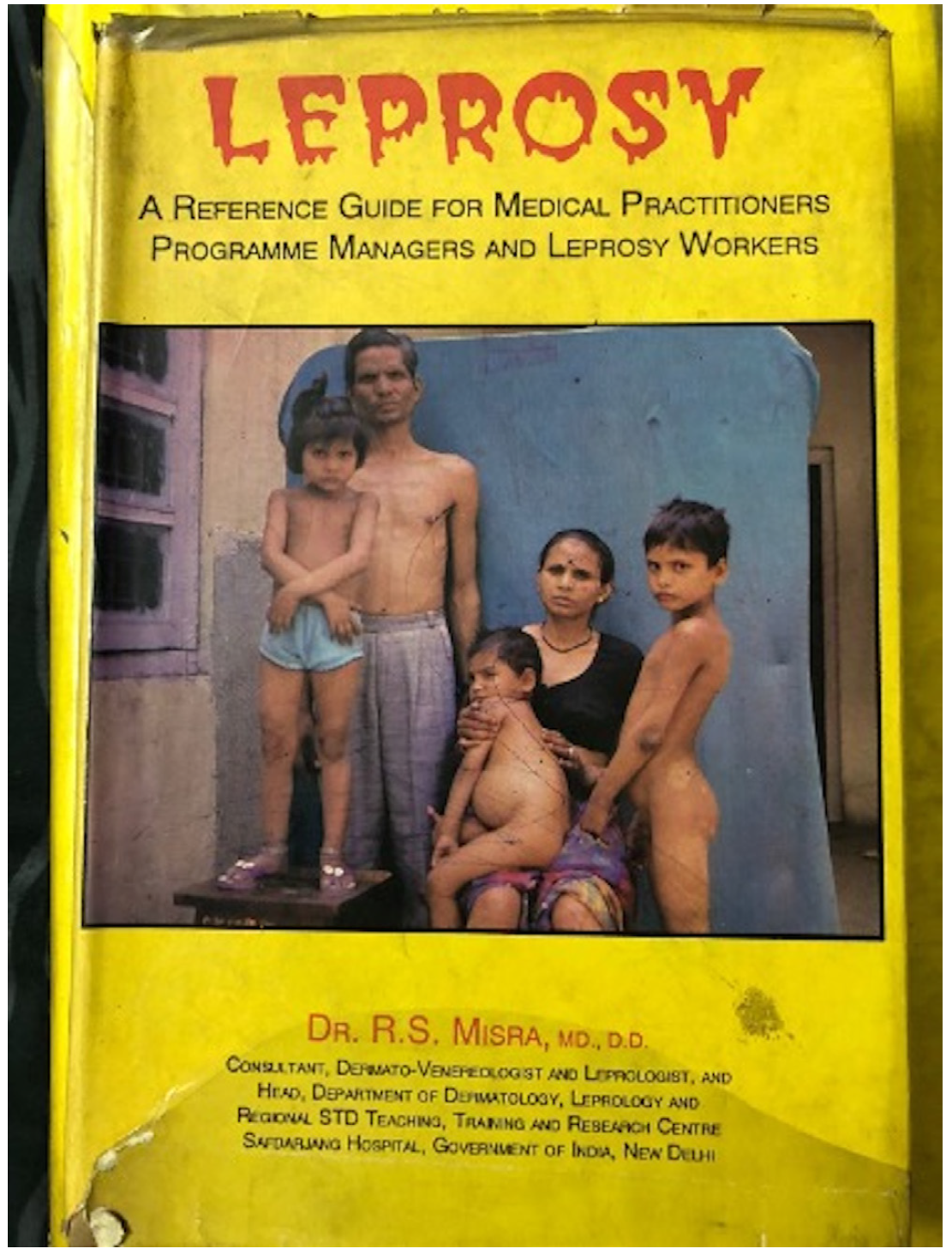
- Cover of Leprosy: A Reference Guide for Medical Practitioners, Programme Managers, and Leprosy Workers by R.S. Misra (1993).
IADVL Textbook of Dermatology (First edition 1994, Fifth edition 2022, Bhalani Publishing House)
Spanning two volumes and over 1,400 pages, this was the first national postgraduate dermatology textbook tailored for Indian and Third World audiences [Figure 9a]. It offers comprehensive coverage of leprosy, with a colour atlas and clear language for beginners. The fifth edition, published in 2022, expanded to three volumes, updating sections on leprosy, including epidemiology, bacteriology, immunopathogenesis, clinical features, treatment, and control programs [Figure 9b].
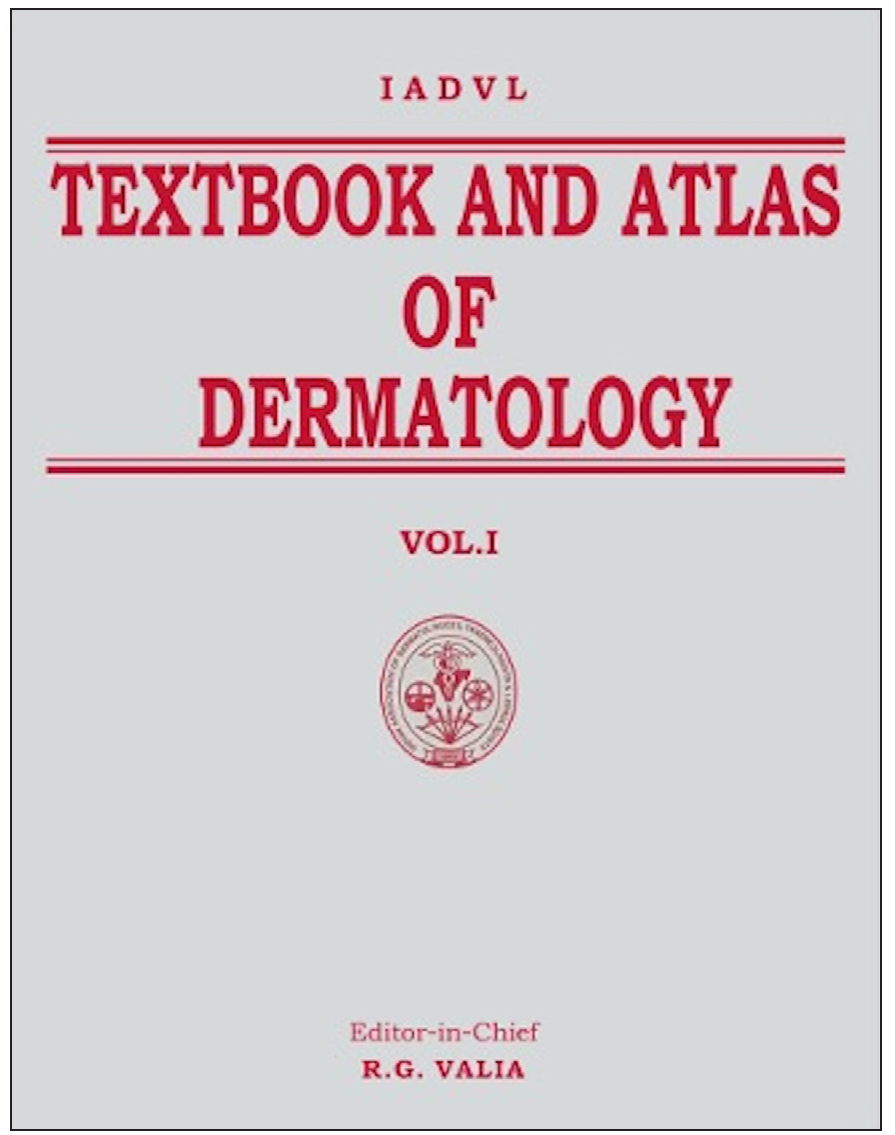
- Cover of IADVL Textbook of Dermatology (First Edition, 1994).
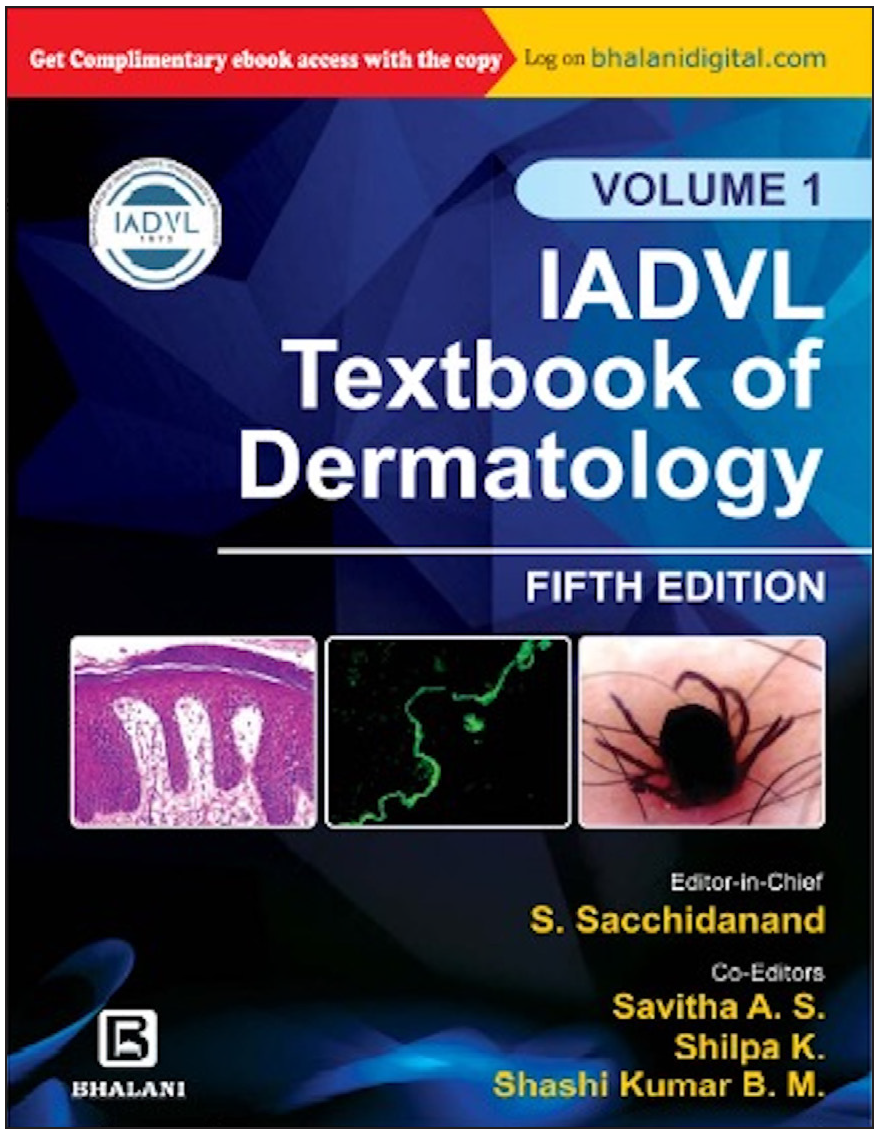
- Cover of IADVL Textbook of Dermatology (Fifth Edition, 2022).
Textbook of Dermatology, Venereology and Leprology (DM Thappa, First edition 2000, Elsevier publisher, Fourth edition 2015, Elsevier India)
This book provides an accessible platform for understanding the key foundations of leprosy. It succinctly explains common phenomena, clinical signs, and bedside and laboratory tests while incorporating new figures, tables, and case scenarios. Designed for quick reference and preparation for examinations, it is a reliable resource for both students and practitioners. The book is regularly revised to reflect the latest developments [Figure 10].
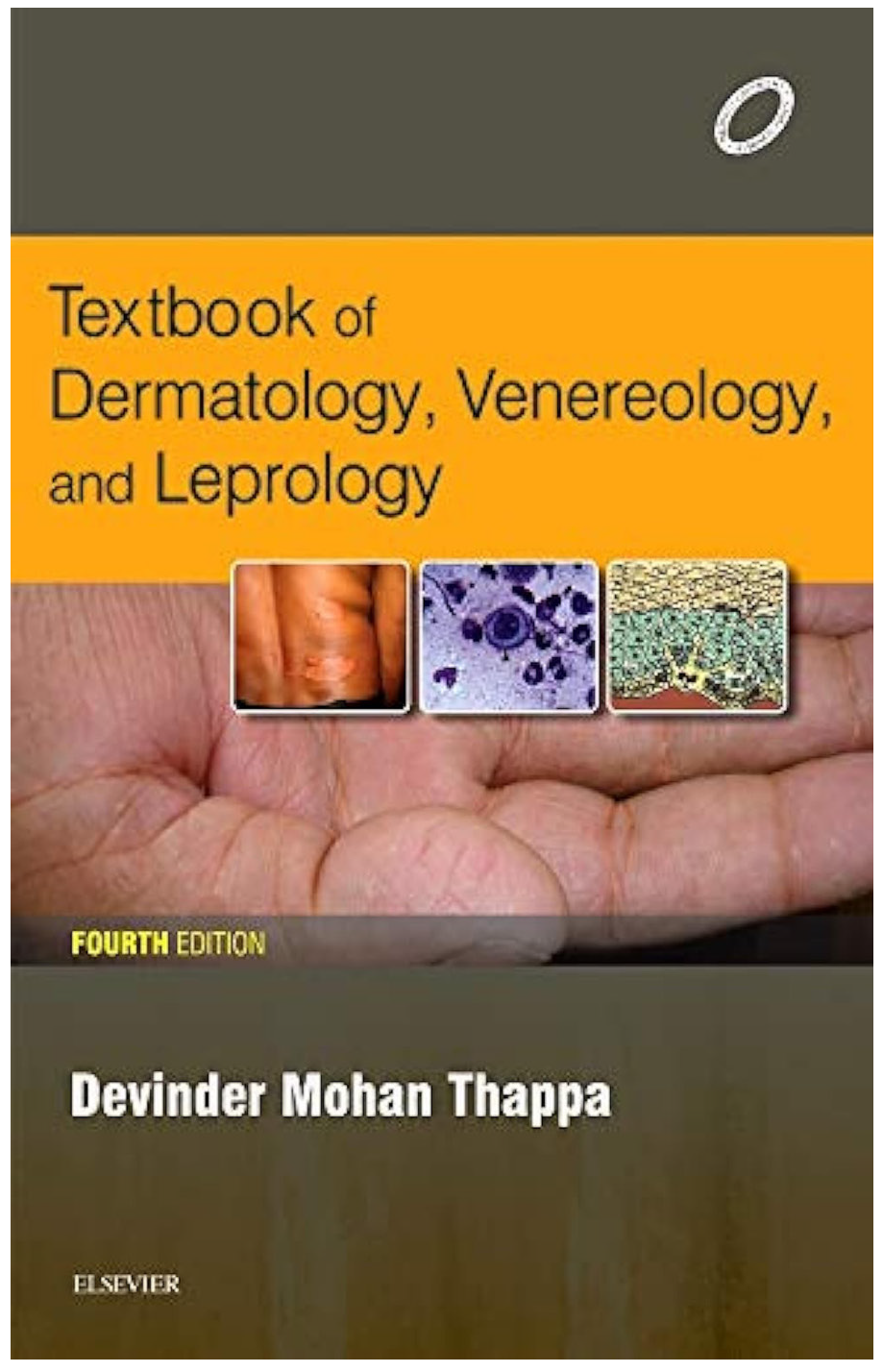
- Cover of Textbook of Dermatology, Venereology, and Leprology by Dr. D.M. Thappa (Fourth Edition, 2015).
All about Leprosy (PVS Prasad, First edition 2005, Second edition 2016, Jaypee Brothers Medical Publishers)
This comprehensive resource bridges leprosy’s historical roots with modern medical advancements. Across 22 chapters, it covers microbiology, pathology, clinical features, diagnosis, reactions, treatment, rehabilitation, and surgical approaches. Designed for students and healthcare professionals, it includes practical appendices, viva questions, and user-friendly illustrations, filling a crucial gap in Indian leprosy literature [Figures 11a and 11b].
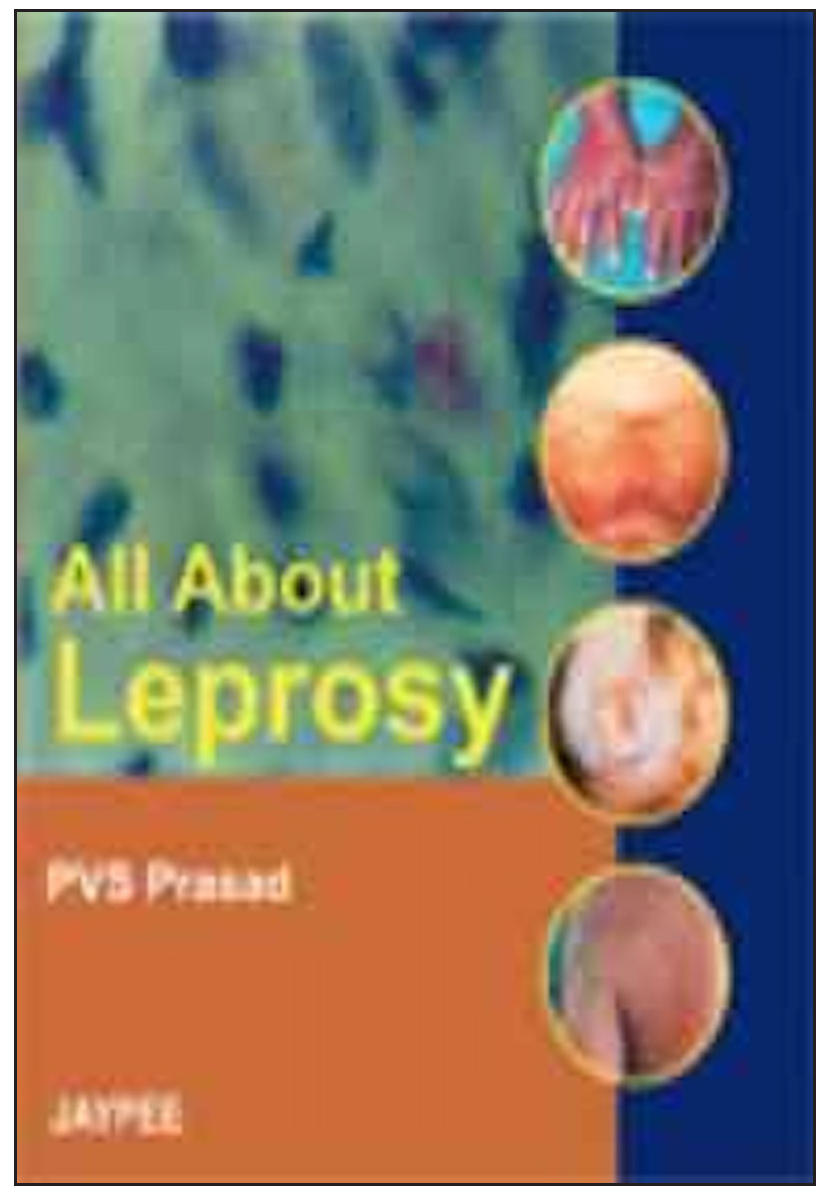
- Cover of All About Leprosy by Dr. P.V.S. Prasad (First Edition, 2005).
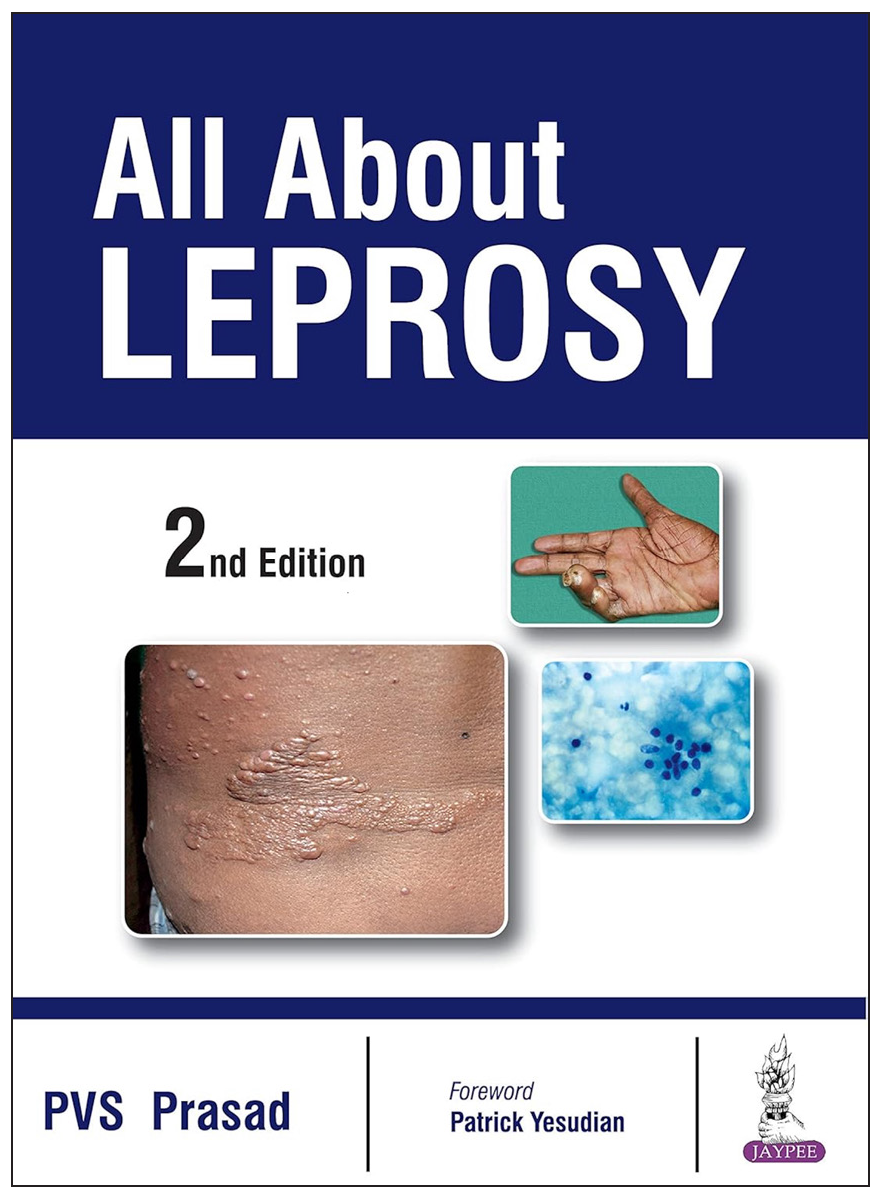
- Cover of All About Leprosy (Second Edition, 2016).
IAL Textbook of Leprosy (Hemanta Kumar Kar and Bhushan Kumar, First edition 2010; Bhushan Kumar and Hemanta Kumar Kar, Second edition 2017; Bhushan Kumar, Hemanta Kumar Kar, and Sunil Dogra, Third edition 2023, Jaypee Brothers Medical Publishers)
The first edition of this textbook [Figure 12a] emerged in the post-elimination era, consolidating research and advancements in leprosy. Designed to enhance the knowledge possessed by clinicians, researchers, and educators, it integrated contributions by national and international authors, offering insights into migration, morbidity, and regional disease patterns. The Second edition expanded on all these topics and added some more [Figure 12b].
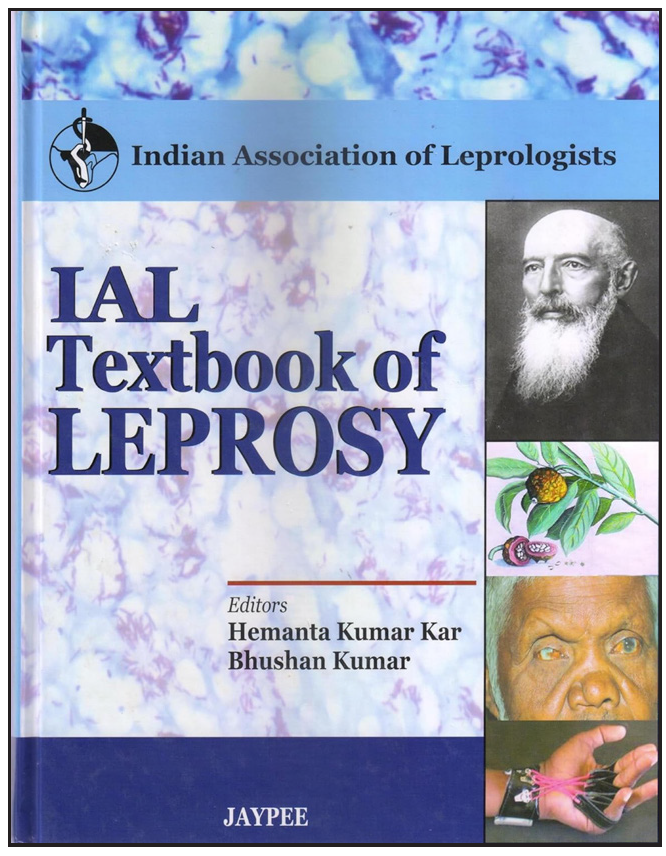
- Cover of IAL Textbook of Leprosy (First Edition, 2010).
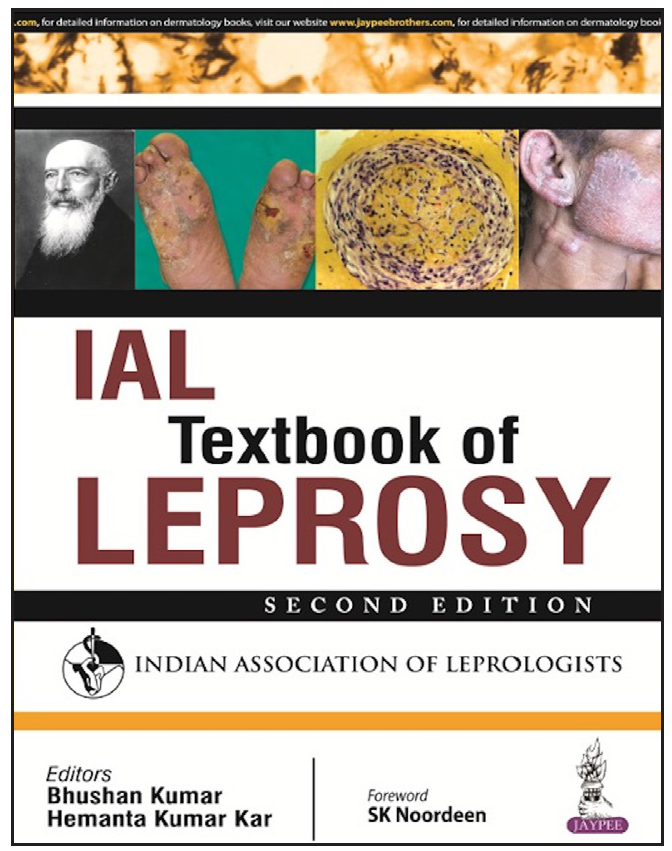
- Cover of IAL Textbook of Leprosy (Second Edition, 2017).
The third edition [Figure 12c] builds on the previous editions, expanding and updating the latest available information. It also covers a wide array of topics, including the history, bacteriology, epidemiology, and immunogenetics of leprosy. It features practical guidance on history-taking, clinical examination, and managing complications, such as nerve damage and drug resistance. Special attention has been given to vulnerable groups, including children, the elderly, pregnant women, and those living with HIV or other immunocompromised states. A richly illustrated photo gallery, inclusive of patients of colour, enhances diagnostic accuracy.
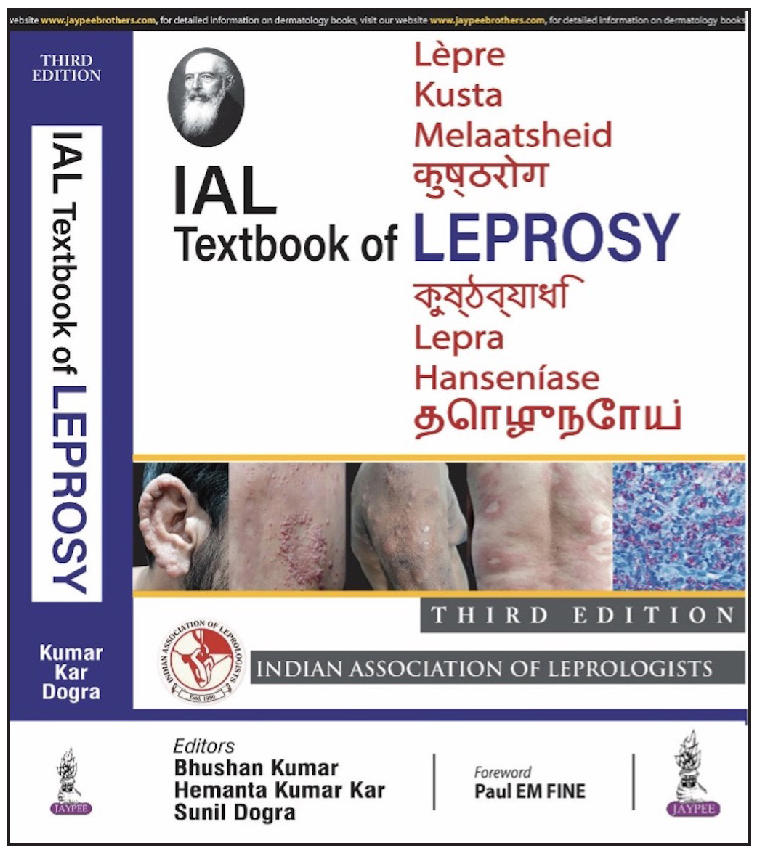
- Cover of IAL Textbook of Leprosy (Third Edition, 2023).
Covering topics like disability prevention, surgical corrections, rehabilitation, vaccines, stigma, and emerging research, this book serves a wide audience, from dermatologists to social scientists. With contributions from 84 experts, it offers the latest insights into diagnosis, treatment, and evolving challenges of leprosy management. It also provides detailed guidance on national control programs, chemoprophylaxis, immunotherapy, and future challenges, catering to both academic and practical needs.
Manual of Histoid Leprosy (VN Sehgal, 2013, Jaypee Brothers Medical Publishers)
In the post-elimination era, histoid leprosy remains a significant challenge. This book offers a detailed guide to its clinical, bacteriological, cyto-histopathological, and immunological aspects [Figure 13]. It combines historic black-and-white images with a modern colour atlas for accurate diagnosis and covers slit-skin smears, histopathology, diagnostic criteria, and differential diagnoses, providing a vital resource for managing these unique cases that serve as reservoirs of the disease.
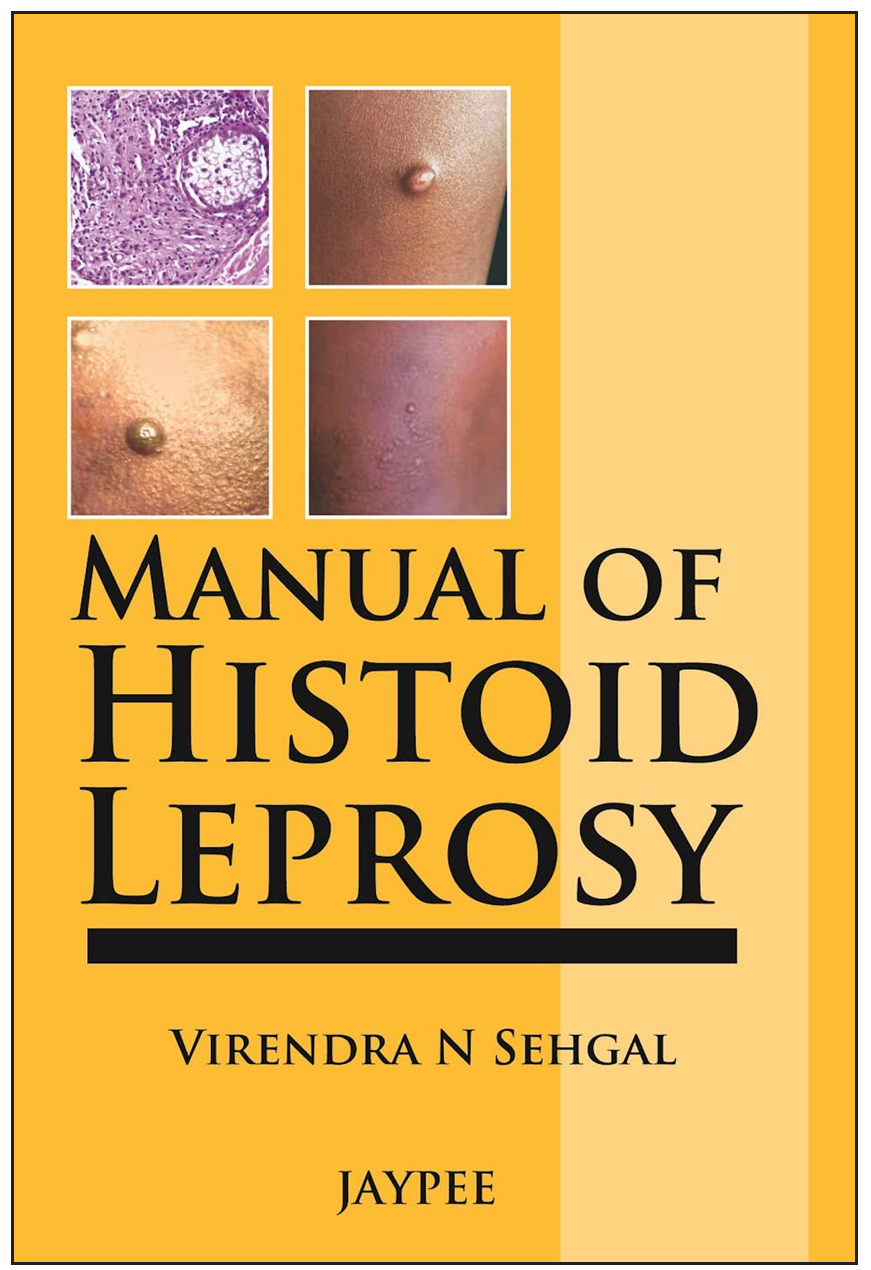
- Cover of Manual of Histoid Leprosy by V.N. Sehgal (2013).
IAL Handbook of Leprosy (Bhushan Kumar, Tarun Narang, V.V. Dongre, Swapan Kumar Samanta, First edition 2018, Bhalani Publishing House)
Rooted in the 2014 IAL conference at Chandigarh, this book consolidates essential information on leprosy for regular use [Figure 14]. It offers practical advice, making it useful for specialists, nurses, physiotherapists, and paramedical workers. With nearly 200 figures, tables, and boxes, it covers the history, epidemiology, genetics, pathogenesis, updated management strategies, and national programs. Special populations such as children, pregnant women, and individuals with HIV/AIDS have also been addressed, making this well-illustrated, concise guide a resource for improving clinical and therapeutic knowledge.
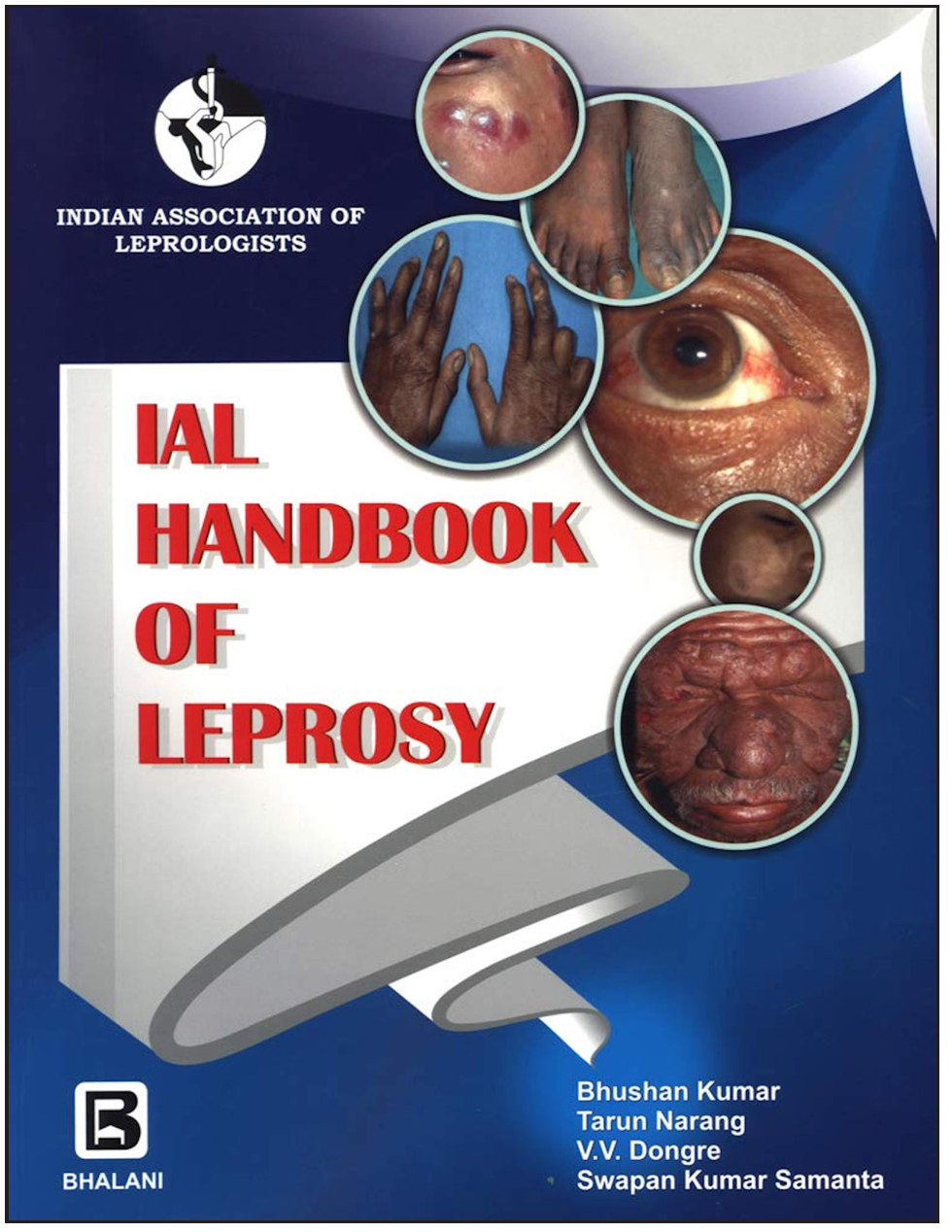
- Cover of IAL Handbook of Leprosy (First Edition, 2018).
Eliminating Leprosy Stigma: A Manual for Community Action (M.S. Raju, P.S.S. Rao, and R.K. Mutatkar, 2022, SR Health Sciences Pvt. Ltd & The Leprosy Mission Research & Resource Centre)
The social stigma surrounding leprosy remains a major obstacle to its control, often overlooked by traditional Information, Education, and Communication (IEC) programs. This manual advocates for empowering patients’ families and communities through targeted activities to combat stigma. By presenting social theories and community-driven practices, it provides a clear framework for addressing the societal challenges of leprosy [Figure 15].
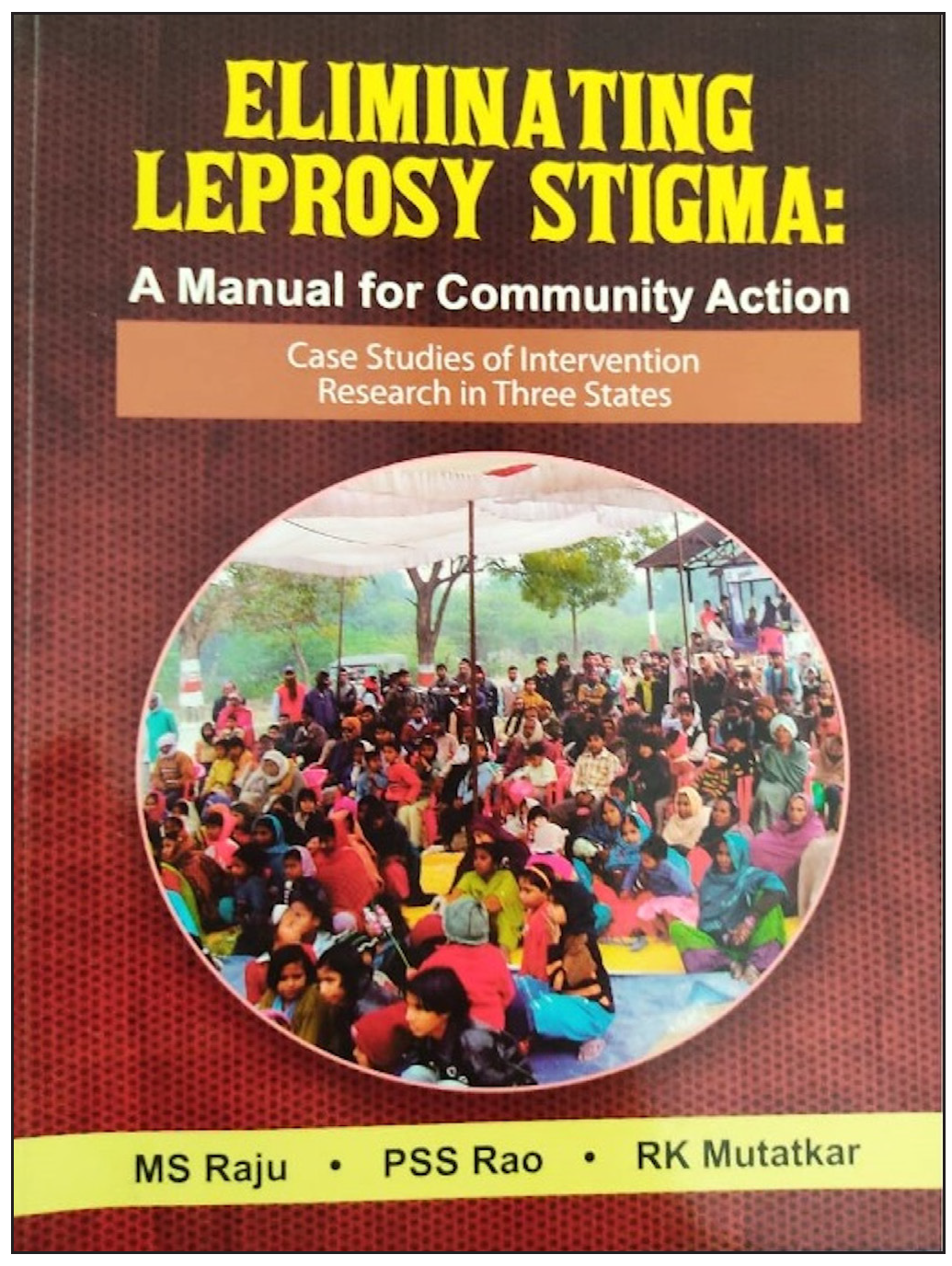
- Cover of Eliminating Leprosy Stigma: A Manual for Community Action (2022).
The historical contexts are remarkably rich, with their origins before the 20th century. While detailed information about many of these works remains elusive, a collage of their covers has been presented in Figure 16.
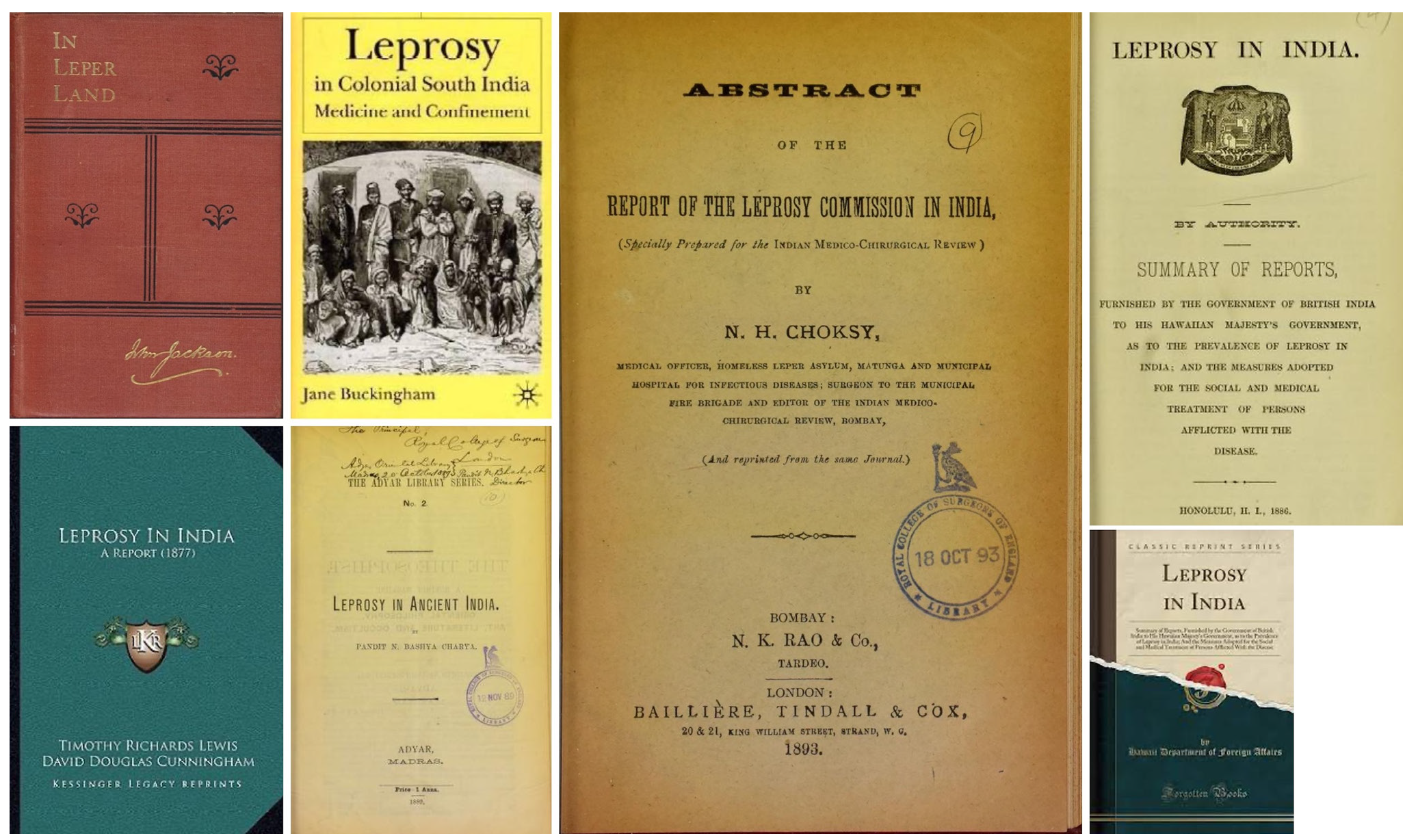
- A collage showcasing the covers of historical texts on leprosy, dating back to before the 20th century.
Resource Centres and Archives for Leprosy Research and History in India
India’s deep historical and cultural association with leprosy is not only preserved through its rich literature but also through numerous institutions, libraries, and archives. These centres across the country hold invaluable records, books, journals, and artifacts chronicling the evolution of leprosy research, treatment, and social perspectives.
Writers’ Building Library, Kolkata, 1780
The Writers’ Building Library in Kolkata preserves West Bengal State government records on leprosy dating back to 1869, primarily in the Medical Branch Proceedings. These archives document the establishment, funding, and management of leprosaria, including facilities like the Albert Victor Leper Asylum in Asansol and others in Bankura, Bhagalpur, Purulia, and Muzaffarpur. Topics include staff employment, equipment procurement, grant allocation, early leprosy control policies, housing for mentally ill leprosy patients, and segregation practices for children of patients.
The Leprosy Mission (TLM), 1874
The Leprosy Mission (TLM) operates multiple archives across India, preserving extensive historical and medical records.
TLM Naini (Allahabad, Uttar Pradesh): Documents date from 1874, including patient records, journals, and the autobiography of founder Sam Higginbotham. The archives also contain organisational records, such as visitors’ books and personal testimonies.
TLM Hospital Vadathorasalur (Villupuram District, Tamil Nadu): A collection of photographs dating back to 1925 and a visitors’ book signed by notable figures such as Dr. Cochrane and Mr. Wellesley Bailey.
Dr. Bandorawalla Leprosy Hospital, Kondhwa (BK), Pune, 1910
Managed by the Pune District Leprosy Committee, this hospital houses an extensive library featuring a diverse range of records. These include patient files, books, journals, sketches, paintings, and surgical records, offering an artistic and clinical perspective on leprosy management over the years.
Calcutta School of Tropical Medicine, 1921
Founded in 1921, the Calcutta School of Tropical Medicine library holds over 65,000 books, journals, records, and gazettes, many from the collection of the Asiatic Society. It is an important resource for researchers, with historical publications predating 1950, though some have been damaged or lost. Leprosy-specific holdings include reports and books from the late 19th to mid-20th centuries, as well as materials from international research stations like Uzuakoli in Nigeria, dating to the 1960s.
Central Leprosy Training and Research Institute (CLTRI), Chengalpattu, 1924
The CLTRI in Chengalpattu, Tamil Nadu, holds valuable records of clinical and research work, including studies on dapsone resistance and trials that shaped the multidrug therapy protocols of WHO. Archives also include records from the Saidapet children’s clinic.
Indian Philatelic Bureau, Mumbai, 1941
The Indian Philatelic Bureau preserves a unique visual archive commemorating leprosy milestones. Among its holdings are stamps and postal issues featuring Dr. Hansen (issued on July 21, 1973) and the 12th International Leprosy Congress (issued on January 20, 1984). Additionally, a first-day cover dedicated to the Christian Medical College and Hospital in Vellore and a booklet on Indian postage stamps from 1947 to 1997 provide further visual documentation of leprosy-related themes.
Gandhi Memorial Leprosy Foundation (GMLF), 1951
Established in 1951, the Gandhi Memorial Leprosy Foundation (GMLF) has been instrumental in supporting the National Leprosy Eradication Programme (NLEP). It operates in three states with control units, hospitals, a training centre, and a health education unit producing leprosy-related materials. GMLF also houses a social science research centre, archives with administrative records and patient data, and a resource library rich in books, journals, and periodicals on leprosy.
National Medical Library, New Delhi, 1966
As a premier medical library in India, the National Medical Library in New Delhi has supported medical research and education for decades. Its extensive collections, encompassing both historical and contemporary medical literature, are invaluable resources for advancing knowledge in areas like leprosy and other infectious diseases.
Foundation for Medical Research (FMR), Mumbai, 1975
FMR in Mumbai holds archives on the neurobiology of leprosy, including studies on nerve damage, Schwann cells, macrophages, and Mycobacterium leprae cultivation. Its records and publications document critical advancements in diagnostics, immunology, and treatment, making it a key repository for leprosy research in India.
National JALMA Institute for Leprosy and Other Mycobacterial Diseases, Agra, 1976
The National JALMA Institute for Leprosy and Other Mycobacterial Diseases, established in 1976, has been at the forefront of leprosy research in India. Its archives and contributions have played a pivotal role in shaping the understanding and management of leprosy, making it a cornerstone institution in this field.
Pondicherry Regional Centre of the National Archives of India, 1979
This centre holds administrative records of the French colonial government from the 1860s to the 1960s, providing unique insights into official anti-leprosy efforts. The archives include French and English documents such as bulletins, colonial council minutes, and journals detailing public health measures, colonial medical initiatives, and European mission involvement in combating leprosy. Notable entries include a report by Dr. Chatterjee on leprosy in Pondicherry and a thesis by R. Natarajan on its social history.
Moving forward, we should consider the digitisation of these influential books on leprosy and plan to create a dedicated archive to store them as eBooks for easy access and reference. Notably, the digitisation of the IAL Journals Archives was announced as an initiative by Dr. V.M. Katoch, Editor-in-Chief, during the IAL Mid-Term Conference in Ahmedabad on 11 January 2025, signaling a promising step towards preserving and disseminating valuable leprosy literature.
Conclusion
Leprosy literature in India showcases a deep commitment to understanding and addressing this ancient disease. From early foundational texts to modern works tackling emerging challenges, this evolution mirrors advancements in medicine and society. Archival centres preserve this legacy, highlighting India’s pivotal role in combating leprosy and fostering hope for a future free from the disease and its stigma.
Declaration of patient consent
Patient’s consent not required as there are no patients in this study.
Financial support and sponsorship
Nil.
Conflicts of interest
There are no conflicts of interest.
Use of artificial intelligence (AI)-assisted technology for manuscript preparation
The authors confirm that there was no use of AI-assisted technology for assisting in the writing or editing of the manuscript and no images were manipulated using AI.





